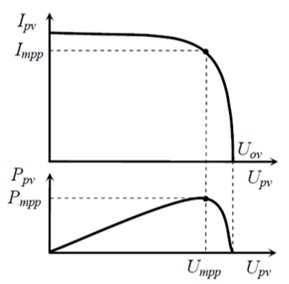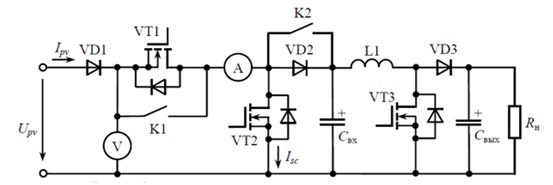Abstract
Content
- Introduction
- 1. Theme urgency
- 2. Goal and tasks of the research
- 3. Features of energy generation by solar generators
- 3.1 Ways to generate electricity and heat from solar radiation
- 3.2 Features of the optimal operation of photovoltaic cells
- 3.3 Algorithms for finding the maximum power point
- 4. The use of microcontrollers in industry
- Conclusions
- List of sources
Introduction
The object of the course project research is the STM32F407 VG microcontroller based on the STM32F4 Discovery debugging module and its application in renewable energy management systems
1. Theme urgency
Green energy is now the main direction of energy development in Europe and the world. For example, in Germany, the process of abandoning atomic energy is currently in full swing, and by 2025 it is planned to close all nuclear power plants.
The master's work is devoted to the implementation of the control system of photovoltaic cells, namely the implementation of the algorithm for finding the optimal power point based on the STM32F407VG microcontroller.
2. Goal and tasks of the research
The aim of the course project is to study the 32-bit microcontroller architecture ARM Cortex-M4 based on the debug board STM32F4 Discovery. Development of a laboratory workshop for the study of the basic capabilities, devices and characteristics of the board and its management of automatic control systems, systematization, consolidation, improvement and expansion of knowledge in the field of studying microcontrollers; training in the independent use of technical literature, reference books, GOSTs and other necessary sources.
3. Features of energy generation by solar generators
3.1 Ways to generate electricity and heat from solar radiation
Photovoltaics - generation of electricity using photovoltaic cells.
A photocell is an electronic device that converts photon energy into electrical energy.
The most efficient, from the energy point of view, devices for converting solar energy into electrical energy are semiconductor photoelectric converters (FEP), since this is a direct, one-step energy transfer. The efficiency of industrial-scale photovoltaic cells averages 16%, with the best samples up to 25%. [7] In laboratory conditions, an efficiency of 43.5% has been achieved, 44.4% , 44.7%

Figure 1. The use of solar panels in alternative energy
Solar power stations cannot work at night, and also cannot work effectively in the morning and evening hours of the day. At the same time the peak of energy consumption falls in the evening. In addition, the performance of a solar power plant varies greatly depending on changes in the weather. To overcome these shortcomings, you must either use efficient electric batteries (today it is an unsolved problem) or build storage power plants that occupy a large area, or use the concept of hydrogen energy, which is still far from economic efficiency. [7] The problem of the dependence of the performance of a solar power plant on the time of day and weather. The surface of the photoelement should be cleaned from dust and other contaminants. With their area of several square kilometers, this is problematic. The efficiency of photocells decreases significantly when heated, so there is a need to use cooling systems, usually water cooling systems [7].
A solar cell is several integrated photoelectric converters (photocells) - semiconductor devices that directly convert solar energy into direct electric current, in contrast to solar collectors that produce heat-transfer material.
Various devices that allow solar radiation to be converted into thermal and electrical energy are the object of research in solar power engineering. The production of photovoltaic cells and solar collectors is developing in different directions. Solar panels come in various sizes, from micro calculators built into rooftops of cars and buildings.
3.2 Features of the optimal operation of photovoltaic cells
It is known that global electricity consumption is increasing annually, and, as expected, further growth will be due to population growth and the increasing demands of the modern lifestyle. Increasing electricity demand leads to the rapid depletion of traditional fossil fuels and exacerbates the problem of environmental pollution [8]. Therefore, there is a need to develop alternative (renewable) energy sources to ensure sustainable energy supplies to the consumer, as well as to reduce local and global environmental pollution [6] [8].
Solar energy is one of the most suitable options for generating electricity, since it is inexhaustible, completely free (in terms of its availability) and environmentally friendly. Many countries are switching to using photovoltaic (PV) electrical power generation systems, even at high costs. Over the entire history of power generation, great strides have been made in improving the technology of PV cells, but the overall efficiency of the solar module is still low. On the current-voltage characteristic (VAC) of the solar module, there is a unique point with coordinates (Umpp, Impp) at which its output power reaches its maximum [8]. Therefore, to achieve maximum efficiency of the solar module when building a PV system, it is necessary to use the maximum power point tracking algorithm (MPPT) to transfer the maximum solar module power to the load under these conditions.

Figure 2. Maximum power point on the IVC of the solar cell
3.3 Algorithms for finding the maximum power point
The foreign literature describes numerous MPPT methods of varying complexity. In commercial products, the most widely used methods are perturbation and observation (perturbation and observation - PO) and increasing conductivity (incremental conductance - 1C) for their simple control structures and ease of implementation [8] . For PV systems with low MPP tracking, methods such as constant voltage (CV) and current, short-current pulse (SC), and open circuit voltage (OC) are used. These methods require fewer sensors and are inexpensive to implement. With the development of computer technology, MPP search methods based on computational intelligence (C1) have become popular due to their adaptive nature, which are very effective when working in partial shading of solar modules and rapidly changing light. C1 methods are generally divided into artificial intelligence (A1) and evolutionary computation (EU) methods [7 ].
All the traditional MPP tracking methods discussed below can be categorized as perturbation and observation methods. The main link of the PV system presented in Fig. 2, is a DC-to-DC converter, matching the output impedance of the solar module or battery (SB) with the load resistance. As a result of measuring (observing) the parameters of the SB, the MPP search algorithm corrects the reference voltage Uref, which is the driver for generating a new value of the output voltage of the SB and disturbing the photovoltaic system [7]. As a voltage regulator, as a rule, a proportional-integral regulator or a hysteresis type regulator is used. In simpler implementations of tracking methods for MPP, the voltage regulator can be removed from the presented structure, and the pulse-width (PWM) modulator will generate the open state of the power key of the APN according to the results of the MPP search algorithm, for example, by changing this duration with a constant step towards increase / decrease [8].

Figure 3. Typical control structure for traditional methods of tracking the maximum power point
When analyzing the effectiveness of a particular MPP search method, a comparative analysis of the power generated by the solar module is carried out under the same other conditions. In this case, the used PPN (lowering or increasing type) must ensure the implementation of each method without changing the strength elements. The paper proposes a step-up control circuit with a microcontroller control system that allows the implementation of a perturbation and observation algorithm.

Figure 4. Boost stabilizer circuit
4. The use of microcontrollers in industry
Modern systems are becoming more complex, and developers are starting to switch to 32-bit systems. The power of 8-bit is limited, while their cost is comparable to the new 32-bit microcontrollers. STM32 is a microcontroller built on the ARM Cortex-M3 core [2]. This core has many advantages, which will be listed below, but its main advantage today is its versatility. In two years, the Cortex-M3 has become an industry standard. This is evidenced by the number of manufacturers that have joined this architecture. All major manufacturers of microcontrollers that are present in Russia, except Microchip, have or are developing solutions based on this architecture: STMicroelectronics, Texas Instrument, NXP, ATMEL, Analog Devices, Renesas, etc. ST was one of the first to release its Cortex-M3 microcontroller (2007) and quickly became the dominant player in this market [3]. If you suddenly need to switch from one manufacturer to another (disruption of supplies, lack of necessary libraries, new functional requirements, price increases, etc.), then the part of the program code associated with the core will not even require a change. It will only be necessary to work at the level of peripheral drivers. The result is that if you write a program code with a clear division between the core and the periphery, you can provide the conditions for a very fast transition from one manufacturer to another. There remains, of course, the problem of reworking the PCB[5].
One of the reasons for the worldwide popularity of the STM32 family is maximum developer comfort. If the universality of the STM32 core allows you to change the manufacturer with minimal software code costs, then pin-to-pin compatibility within the STM32 family allows you to change the amount of memory (flash memory and RAM) and peripherals (Ethernet, USB, CAN, etc.) without touching the circuit board. “Pin-to-pin compatibility” means that for a single case size, all signals are stored on the same I / O for different variants of microcontrollers of the family [1].

Figure 5. Application of the microcontroller STM32F407VG in the system of adjustable electric drive
STM microcontrollers are used mainly in native systems. They can also be used in industry. This is facilitated by the low cost of the core, as well as increased noise immunity and noise immunity, relative to microcontrollers of the same class. However, for use in industry, it is necessary to coordinate the levels of signals, and independently develop all the necessary power strapping
Conclusions
MPP controllers play an important role in PV systems, the load of which is either a battery or an industrial network. When building stand-alone battery-free systems, there is no need for MPP tracking.
An overview of the MPP search algorithms shows that traditional algorithms have disadvantages such as pulsations around MPP, errors in tracking MPP during abrupt changes in environmental conditions. Therefore, in practice they apply modifications of traditional algorithms.
The master's work is devoted to the study of alternative energy sources and the implementation of the method of finding the optimal power point based on the STM32F4 microcontroller. In the framework of the research carried out:
- Research on the principles and methods of generating energy in renewable energy sources
- Algorithms for finding the point of optimal power of a photoelectric element have been studied
- The algorithm of the method of observation and disturbance is implemented using the STM32F4 microcontroller
- Analyzed work results
When writing this essay master's work is not yet completed. Final Completion: June 2019. The full text of the work and materials on the topic can be obtained from the author or his manager after the specified date.
List of sources
- Лабораторный практикум для изучения микроконтроллеров архитектуры ARM Cortex-M4 на базе отладочного модуля STM32F4 Discovery / Бугаев В.И., Мусиенко М.П., Крайнык Я.М. – Москва-Николаев: МФТИ-ЧГУ, 2013. – 71 с.
- Гербер Шилд. С++ Руководство для начинающих. 2-е издание. Пер с англ. – М.: Издательский дом Вильямс,2005-672с.
- Reference manual STM32F4 – RM0090 – Advanced ARM -32 bit MCUs
- STM32 Tutorial - Moritz Diller, Erlangen – 2014-72s.
- STM32 32-bit ARM Cortex MCUs - STMicroelectronics - http://www.st.com/en/microcontrollers/stm32-32-bit-arm-cortex-mcus.html?querycriteria=productId=SC1169
- Теория и практика энергосбережения - http://stroypuls.ru/pso/2012/143-sentyabr-2012/57618/
- Лукутин Б.В. Возобновляемая энергетика в децентрализованном энергоснабжении. Монография. –М.:Энергоатомиздат, 2008. – 231с.
- Роза А. Возобновляемые источники энергии. Физико-технические основы. –М.: Издательский дом МЭИ 2010, 704с
